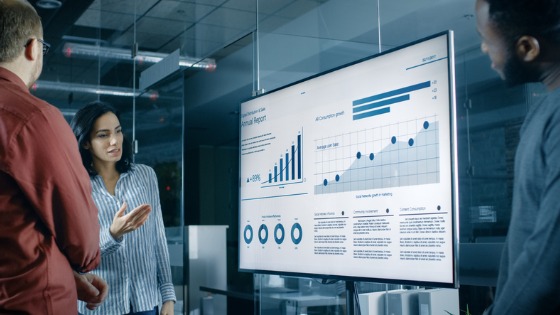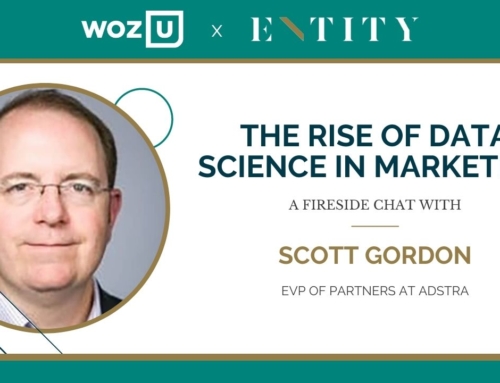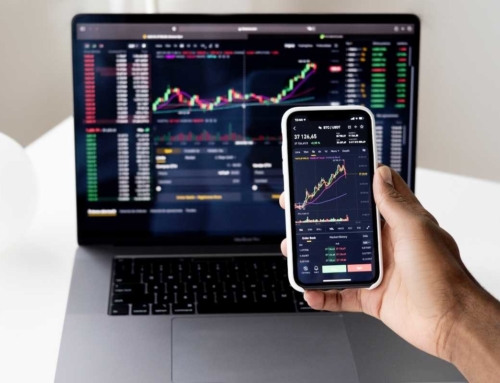Think back to the last class, conference, or seminar you attended. What do you remember? Bullet points or visualization of data?
Human eyes register 36,000 visual images per hour.
We read between 15,000 and 18,000 words per hour. Almost 80% of the information that our brains process is visual.
Data needs to be visual in order to be remembered.
What is Visualization of Data and Why it Matters
Data visualization is a graphical representation of data. Instead of showing a spreadsheet full of columns and rows, data visuals would display the information in a pie chart, line graph, or scatter diagram. By processing data to display in visual formats, we are able to see:
- Patterns appear
- Exceptions standout
- Trends emerge
Visualizing data provides insights that aren’t readily available when looking at text or numbers. They help individuals make decisions quicker based on data.
A Brief History
We may think of data visualization as computer-generated graphics based on volumes of data points, but it has been around long before computers.
Maps are a visualization of geographic data, and they have been around for 8,000 years.
In the 11th century, an unknown scribe created a planetary chart, which is considered the first non-map instance of data visualization.
It wasn’t until the 19th century that people began to think about data visualization. By the late 19th century, educated individuals in Western Europe and the United States were performing statistical analyses.
Florence Nightingale collected data on death rates during the Crimean War to show that more soldiers were dying from poor hygiene than from battle wounds.
She then made a visualization of the data to show to the Queen and Parliament, who immediately authorized funds for improved hygiene in field hospitals.
Today, people have the tools to create charts for data. Spreadsheets can quickly turn personal budget information into pie charts.
With the rise of Big Data, the need for data visualization is increasing. It isn’t possible for humans to analyze millions of data points to produce insightful results in minutes.
How to Use It
Data visualization analyzes the following basic data types.
Temporal Data
Data that captures a moment in time is considered temporal. For example, the rainfall amounts for March 3, April 7, and August 4 were 0.04 inches, 1.00 inches, and 1.5 inches, respectively.
Plotting these data points on a graph produces a single line connecting the data points. Thus, the resulting graph is a one-dimensional linear diagram.
Hierarchical Data
The most common form of data visualization for hierarchical data is the family tree or organizational chart.
The graph attempts to show a relationship between data points.
Typically, there is a single point of origin. All data points flow from the point of origin, either directly or through an intermediary.
For example, your maternal grandparents are the single point of origin for all their descendants.
Their children — your parents — would be linked to them directly; however, grandchildren are linked through an intermediary — your parents.
As long as the data relationships are linear, hierarchical visualization is a concise way to show multiple relationships.
Network Data
The most common way to visualize connections among different datasets is by using network maps or node/link diagrams.
A company has three locations, each with a separate network. The individual networks are mapped separately and then connected to each other.
By visualizing the network configurations, the load on each network is easy to identify. Adjustments can be made to balance the load among the three locations.
Network visualizations are a way to show relationships without lengthy explanations.
Multidimensional Data
Visualizing data in more than one dimension means representing more complex relationships.
It means reducing volumes of data to a graphic that is easier to understand.
Examples of multidimensional displays include:
- Pie charts compare amounts by percentages or amounts.
- Histograms compare time periods with a known variable.
- Lastly, scatterplots organize data points to show correlations between two or more variables.
Using the right visualization tools can make multidimensional images into useful insights.
Geospatial Data
Geospatial or spatial data visualizations means overlaying data on a map or other representation of a physical location.
Common uses include depicting political affiliation by location or indicate market share across multiple physical markets.
Types of Chart Data
Charts, tables, and graphs are just the beginning of data visualization techniques.

In fact, the most common types are charts, graphs, and tables.
Dashboards, maps, and infographics are other data visualization examples that get widespread use. More specialized charts include:
- Box-and-whisker Plots
- Cartogram
- Dot Distribution Map
- Gantt Chart
- Matrix
- Lastly, timeline
With the help of data visualization tools, data can be transformed into any number of configurations.
What is Visualization of Data in Data Science?
According to the Data Science Association, data science is the scientific study of creating, validating, and transforming data to create meaning.
Indeed, it uses scientific principles, machine learning and algorithms to find meaning and to extract actionable insights from large data sets.
Data visualization is creating a visual representation of the data. Data science needs data visualization, just as it needs data science.
Remember Florence Nightingale?
She collected the statistical information but realized that the numbers could not convey the magnitude of the problem. Her solution was to visualize the data so everyone could see the problem.
We may have more tools, but the purpose is the same: to present data in a form that makes decision-making easier. That’s why a career in data visualization can be so rewarding.
Through the visualization of data, Ms. Nightingale improved conditions in field hospitals and saved the lives of soldiers.
If you are looking for a meaningful career, explore the data science programs powered by Woz U.





